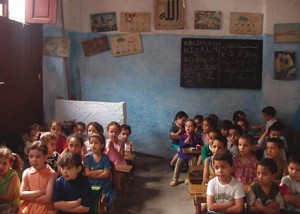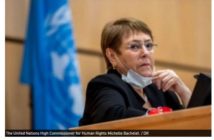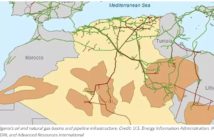Al Jazeera
Oumaima Elmorabete contributed reporting
Just outside a mountain town near Morocco’s coastal city of al-Hoceima, Aithmanan Primary School’s six small buildings, each painted in faded mint and cream, encircle a dirt courtyard.
Scrawled next to the entrance of one building is a quote from French author Victor Hugo: “Every child we educate is a man we gain.”
Here, Ahmed el-Allaoui, 35, teaches a class comprised of 28 students, ranging from third to sixth grade.
Every school day, he rises at 5am to take a 20-minute taxi ride into Tamassint, and then a 45-minute trek out to Aithmanan. This is a hardship – especially during the rainy season – that he is willing to undergo for his students, Allaoui told Al Jazeera.
“I think the government should fix the roads and make transportation [available] for students,” said Allaoui, who holds degrees in Islamic education and Amazigh culture. “This would help both people in the village and students as well.”
While virtually every Moroccan child under the age of 12 is enrolled in primary school this year, 18 percent of Moroccans aged 15 to 24 remain illiterate in a country where a third of all citizens cannot read or write.
The government spends nearly a quarter of its budget on education, but it struggles to provide access in remote regions like Tamassint, where many students walk long distances to primary school, often dropping out before middle school, which usually lies even farther away from home.
There is a large gulf between rural and urban areas in Morocco when it comes to enrolment in middle school education. According to the UN’s most recent data, 83 percent of Moroccan students make the transition from primary school, and the majority of all out-of-school children live in rural areas.
Many drop out in order to work and support their families or, in the case of some girls, to get married, according to Mohamed Melouk, a professor of research methodology and curriculum development at Mohammed V University in Rabat.
“It’s not a question of having this negative attitude about education. They give up for all sorts of reasons, basically financial,” said Melouk.
Morocco’s government has made school more accessible for some rural youth, according to Melouk, who says state projects that brought bikes to students and material stipends to their parents have helped.
The National Initiative for Human Development, launched by King Mohammed VI in 2005, made these efforts possible.
Other projects fell under the Education Emergency Plan, enacted between 2009 and 2012. It aimed to extend access and improve quality of education by creating more preschools and renovating buildings in remote areas.
The government also built new schools in central towns and constructed boarding houses for rural students in select cities.
As a testament to the success of these reforms, primary enrolment more than doubled in rural areas between 1990 and 2008. But Melouk believes that making further progress remains a challenge.
“It’s not enough to start something. You have to ensure sustainability through continuous funding, continuous effort, and maintenance,” he said. “It takes a lot of time and effort to identify the specificities of each area.”
The Ministry of National Education was unavailable for comment.
Another struggle hinges on language. Most students enter the Aithmanan school speaking only their native Tarifit – an Amazigh dialect – leaving them unprepared for instruction in standard Arabic and French.
There are also pressures to pass students regardless of competency, and Allaoui says he faces added challenges teaching mixed-grade classes.
“It’s not fair for those kids to be taught in joined classes, but I understand the government cannot afford one teacher for three students,” he said. “In the centre where I studied [to become a teacher], they were saying that having joint classes is an exception; when I started working, I found that it is normal in these areas.”
The region around Aithmanan is bathed in sunshine and surrounded by green hills etched with winding dirt paths. Tiny houses fenced in by cacti or weeds dot the landscape, while sheep graze beside the road.
Rural Morocco remains a “forgotten world” faced with unique educational challenges, according to Amina Hnida, 59, a regional director based in Rabat for an organised labour group called the National Union of Work.
“When you take a teacher from a big city and send him to an isolated area with no internet access, phone service or ability to communicate with people, what do you expect?” she said.
Haitam Dardari, 25, hails from the seaside city of Mohammedia, near Casablanca. Two years ago, he was sent to teach in a small mountain settlement three hours south of Marrakech.
It is poorer and more remote than Tamassint, accessible only by a zigzag of rocky paths carved into the slopes.
“When I first came to this area, I had heard before about its circumstances from other teachers – though hearing about it is not like living here,” said Dardari, whose parents are both educators. “I never thought these conditions existed in Morocco.”
Dardari’s high placement test score allowed him to choose a region with running water and electricity, but he knows teachers in other areas who must walk for hours just to phone their families.
One acquaintance quit, leaving the students with no instructor. But Dardari, who also works to improve his students’ welfare through an organisation that provides the community with clothes, furniture and medicine, refuses to do so.
The fourth, fifth, and sixth graders in Dardari’s class sit three to a desk for lessons written out on the room’s single blackboard. Last year, he taught four grades here. One of his fourth grade students could not write his own name in Arabic.
According to Dardari, the government mandates that he graduate at least two-thirds of his sixth grade class.
Still, some parents ask Dardari to hold their children back an extra year so they can continue to collect the Tissir, a government programme launched in 2008 that provides stipends to parents in regions with high poverty and dropout rates.
Their reason is simple: The nearest middle school lies two hours away and transportation is only available on certain days.
“When [the students] drop out, it means their lives are over,” Dardari said. “The only thing that can encourage you to continue working in these areas is those students. If I refused to work here, and others did too, who’s going to teach them?”
Back in the north, Allaoui ponders the same question.
Many Tamassint students still excel despite the odds against them, and according to Allaoui, “they have a great desire to learn and study – their parents help them if they are educated”.
One example is Mohamed, a second-grader at Aithmanan. “I like my teacher, and I like my school,” he told Al Jazeera. “I want to be a teacher.”
Kiannah Sepeda-Miller and Julia Barstow spent several months in Morocco on an SIT Study Abroad programme and produced this story in association with Round Earth Media, a nonprofit organisation that mentors the next generation of international journalists. Oumaima Elmorabete contributed reporting.








